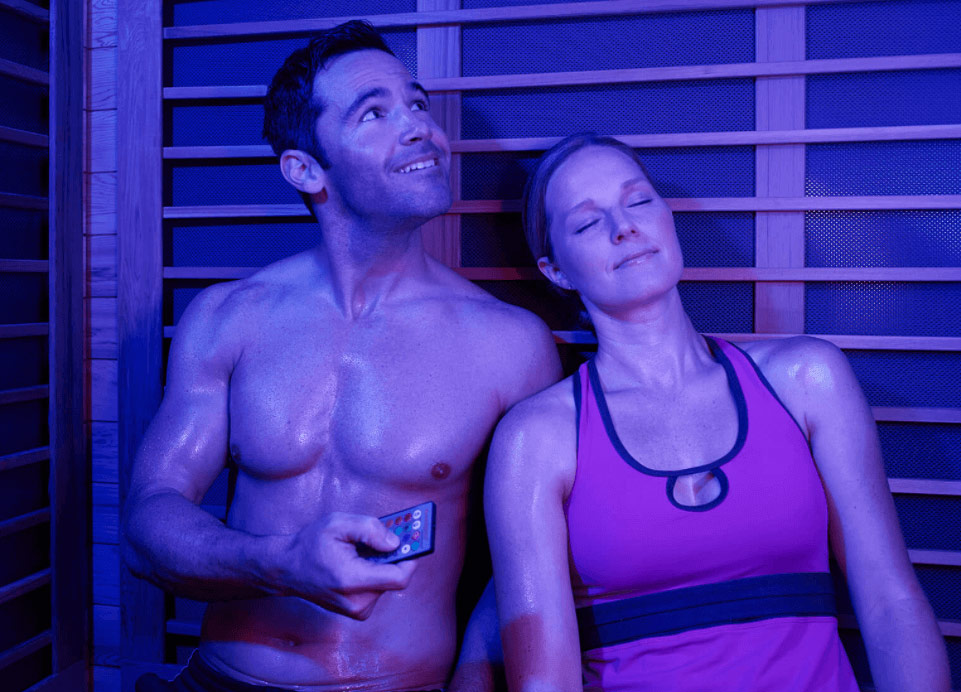Are you sick and tired of having asthma or allergies ruin your life? Could a portable sauna help? The health advantages of saunas have been widely touted, but can they help those with asthma or allergies breathe easier? Here, we'll investigate the claims that portable saunas can improve respiratory health using expert opinion and scientific evidence.
Those with asthma or allergies can benefit from using a portable sauna. Saunas' heat and steam can help break up mucus in the lungs, allowing for easier breathing. Asthmatics, people with bronchitis, and those with sinus congestion can all benefit greatly. The anti-inflammatory effects of saunas on the immune system have been associated with better respiratory health.
But these are not the only advantages of portable saunas for respiratory conditions or allergies. In our comprehensive article, we will delve into how saunas can improve lung function and boost the immune system. We will also go through how to use a portable sauna most efficiently and securely. We've consulted a renowned pulmonologist who will share her expertise to provide you with the most valuable insights. So, without further ado, let's explore the rejuvenating world of portable saunas and their potential to enhance respiratory well-being.
How To Make Sense Of Allergies And Other Breathing Problems?
Allergies and other respiratory illnesses affect millions of people every year. They might be anything from a mild annoyance to a potentially fatal illness. We will cover the impact these illnesses have on daily life and wellness and the causes and triggers of respiratory allergies.
Definition And Common Respiratory Conditions
Respiratory illnesses directly or indirectly affect the lungs, windpipe, and nose. Some of the most frequent lung disorders are the following:
- Asthma: Breathing difficulties, wheezing, and coughing are all symptoms of asthma, a chronic disorder caused by inflammation and constriction of the airways.
- Bronchitis: When the bronchial tubes become inflamed, it leads to symptoms including a persistent cough, phlegm production, and difficulty breathing.
- Chronic Obstructive Pulmonary Disease (COPD): Chronic obstructive pulmonary disease (COPD) describes a collection of lung diseases that worsen with time and make breathing difficult.
- Pneumonia is an infectious lung disease characterised by fever, cough, and shortness of breath due to inflammation of the air sacs in the lungs.
- Allergic Rhinitis: Hay fever, or allergic rhinitis, is triggered by an adverse immunological response to airborne allergens.

Influences on Respiratory Allergies
When the immune system incorrectly identifies otherwise harmless substances as harmful, respiratory allergy symptoms result. Allergens that commonly affect the respiratory system are:
- Pollen: During certain times of the year, pollen from trees, grasses, and weeds can aggravate allergy sufferers.
- Dust Mites: Allergic reactions can be triggered by breathing in the droppings of these microscopic animals, which make their home in dust.
- Pet Dander: In certain people, allergens in animal skin, fur, or feathers can cause severe reactions.
- Mould: In humid climates, mould spores discharged into the air can aggravate respiratory allergies.
- Air Pollution: Airborne chemicals, pollutants, and particles can aggravate asthma and other respiratory conditions.
Effects on Regular Activities and Health
Allergies and other respiratory problems can have a devastating effect on a person's quality of life.
- Reduced Quality of Life: Constant coughing, wheezing, and nasal congestion can reduce a person's quality of life by interfering with their regular activities and keeping them up at night.
- Work and School Absenteeism: People with severe respiratory diseases or allergies may need to take time off work or school to recover from their symptoms.
- Emotional and Mental Health: Anxiety, worry, and despair are all common side effects of dealing with a chronic respiratory ailment.
- Limited Physical Activity: Reduced physical activity and increased sedentary behaviour may result from chronic shortness of breath and exhaustion.
- Financial Burden: Some people and their families may struggle financially due to the high cost of medical care, medications, and therapies needed to manage respiratory disorders and allergies.
Why Use A Sauna, And What Are The Dangers?
For thousands of years, people have enjoyed the health benefits of saunas. Possible sauna benefits include stress reduction, pain relief, and enhanced cardiovascular health. Therapeutic uses of sweating go back centuries. Harvard Health Publications reports that the Mayans utilised sweat huts about three centuries ago. One in three Finns regularly utilise saunas despite their long history of use. It's estimated that there are over a million saunas in Australia. Relaxation and heart health are two key sauna benefits touted by proponents. A sauna, though, might only be for some.
Fast Facts On Saunas:
- To unwind in dry heat, many individuals visit saunas.
- It has the potential to offer cardiovascular health advantages similar to those gained from regular exercise.
- It is not recommended to consume alcohol before or while in a sauna.
- Seek medical counsel before using a sauna if you have cardiovascular issues or are pregnant.
Why Heating Yourself Helps Asthmatics?
Sauna Therapy Studies for Asthma and Respiratory Diseases
Several research on the effects of saunas on respiratory disorders in general and asthma, in particular, have been conducted, which is good news. Many people who have asthma find relief from their symptoms after utilising a sauna for a few reasons.
Similar to the effects of exercise, time spent in a sauna raises both peripheral blood flow and heart rate, contributing to better air exchange and oxygenation of tissues throughout the body. People with Asthma have trouble getting enough oxygen to their blood, especially to their extremities. In addition, most people with asthma, including kids, can tolerate sauna time just fine.
The risk of developing respiratory disorders is also reduced by frequent sauna use. A Finnish study followed people who regularly used saunas for 25 years to see what happened to them. There was a 41% reduction in the risk of respiratory disorders among participants who used a sauna 4-7 times weekly compared to those who used a sauna once a week or less. Asthma is one type of respiratory illness that can occur.
In addition, those who went to the sauna between four and seven times a week saw a 37% reduction in their chance of contracting pneumonia. Asthma increases your risk for pneumonia, so knowing there is a natural way to lower that risk is a boon if you have asthma. Of course, you need to develop a regular sauna routine to get all these advantages.
According to research from multiple nations, saunas can reduce asthma symptoms correctly. However, if you're experiencing an asthma attack right now, you should exercise extra caution when utilising a sauna.
Reduced Inflammation Due to Sauna Use
Asthma and inflammation have intimate ties, and saunas can significantly reduce inflammation. Asthma, as you may recall, is a lung inflammation. The scientific findings are as follows:
The same team of Finnish researchers that studied the effects of sauna use on inflammation also looked at how often participants used the sauna. Here, those who used the sauna the most frequently (4-7 times weekly) had "C-reactive protein" levels on average of 1.65 mmol/L, compared to 2.41 mmol/L for those who used the sauna once per week.
You may assess inflammation in your blood in several ways, and C-reactive protein is one of the most essential. Inflammation plays a role in various chronic diseases, including cardiovascular and respiratory issues.
Regular sauna goers had a lower risk of contracting pneumonia, including those with chronic inflammation, according to the same team of investigators. Asthma patients are especially vulnerable to developing pneumonia. Asthma's primary symptoms—inflammation and the risk of pneumonia—are reduced by regular sauna use.
Why Are Infrared Saunas Better For Asthma?
We have already discussed the ramifications of utilising a portable sauna as opposed to a traditional Finnish sauna and the temperature differential between the two types of saunas. The use of much lower temperatures, up to 60 degrees Celsius, is one of the advantages of an infrared sauna. Finnish saunas and other traditional saunas can reach temperatures well above 100 degrees Celsius, putting extra strain on your respiratory system.
Even while you may get your core temperature up pretty high in an infrared sauna, the consensus is that they are considerably easier on the body. The term "core body temperature" refers to the body's internal temperature rather than the skin's temperature at the extremities.
Near-Infrared Light Treats Asthma Directly
The best-infrared saunas expose you to "near," "middle," and "far" infrared heat, the whole spectrum. In general, only the far infrared is emitted by traditional infrared saunas. However, research shows that near-infrared has its own set of useful features and advantages. Both humans and animals are used in this research.

According to human trials conducted in Russia, asthma attacks can be reduced in frequency and intensity with as few as two to four treatments per year. Animal studies demonstrate that a specific type of lung inflammation can be combated, with the added benefits of clearing up the airways and reducing "mucus" buildup (with an effect almost as potent as certain pharmaceuticals).
Threats To Health And Safety Measures
Most people can probably use a sauna occasionally without any ill effects. A person with cardiovascular illness, however, should consult a physician beforehand.
Dangers Associated with High Blood Pressure
Contrary to popular belief, alternating between the extreme temperatures of a sauna and a swimming pool can elevate blood pressure. If you have low blood pressure, ask your doctor before utilising a sauna to be sure you can safely do so. The same goes for people who have just suffered a heart attack.
Dehydration Risk
Sweating causes fluid loss and can lead to dehydration. Dehydration can be especially dangerous for those with health issues, such as kidney disease. Some people may feel sick or dizzy because of the higher temperatures.
Precautions
The following safety measures are also recommended to reduce the risk of harm to human health:
- Avoid alcohol: Dehydration, low blood pressure, irregular heartbeats, and even death can all be brought on by too much alcohol.
- Finnish persons who died suddenly were more likely to have recently used a sauna (1.8% vs. 1.7%), according to a study that followed these people for an entire year. There were a lot of drunk people there.
- Limit time spent in a sauna: Never stay there for 20 minutes at a time. Five to ten minutes is ideal for first-time users. Gradually increasing the period to around 20 minutes will help them acclimatise to the heat.
- Drink plenty of water: It is crucial to replenish the fluids lost during sweating after using any sauna. After a sauna session, it's recommended that people consume two to four glasses of water.
- Avoid sauna use if ill: Sauna use is not recommended for anyone unwell. Before using a sauna, pregnant women and individuals with specific medical issues, such as low blood pressure, should check with their doctor.
- Supervise children: Children above six can safely use a sauna, although this should be done under adult supervision. No more than 15 minutes should be spent there at a time.
FAQs About Sauna
Yes, a portable sauna may offer some relief for individuals with seasonal allergies. It can help open nasal passages, reduce congestion, and alleviate symptoms like sneezing and runny nose. However, individuals with severe seasonal allergies should still seek medical advice and follow their doctor's recommended treatment plan.
Pregnant women should avoid using portable saunas, especially during the first trimester and if they have respiratory conditions or allergies. Saunas can raise the body's core temperature, potentially harming the developing fetus. Pregnant women should visit their doctor for safe respiratory management.
Using a portable sauna has some risks, especially if not used properly. Risks may include dehydration, overheating, and worsening of respiratory symptoms. It's essential to stay hydrated, avoid prolonged sauna sessions, and pay attention to how your body responds. If you have respiratory conditions or allergies, consult your doctor before using a sauna to minimize potential risks.
Yes, a portable sauna can be helpful for sinus congestion and sinusitis. The warm, moist air in the sauna can help reduce inflammation in the sinuses and promote better drainage, alleviating congestion and sinus pressure. However, individuals with chronic sinusitis should consult their healthcare provider to determine if a sauna suits their specific condition.
Using a portable sauna can be safe for individuals with respiratory conditions or allergies, but it's essential to exercise caution. To avoid worsening your illness, ask your doctor before utilising a sauna. People with severe respiratory issues or allergies may need to avoid saunas altogether, while others can benefit from using them in moderation.
Conclusion
Portable saunas have been widely touted as health benefits for those with asthma or allergies, as they can help break up mucus in the lungs, allowing for easier breathing. Asthmatics, people with bronchitis, and those with sinus congestion can all benefit greatly from the anti-inflammatory effects of saunas on the immune system. However, these are not the only advantages of portable saunas for respiratory conditions or allergies.
Respiratory illnesses affect millions of people every year, and common respiratory conditions include asthma, bronchitis, chronic obstructive pulmonary disease (COPD), pneumonia, and allergic rhinitis. Allergens that commonly affect the respiratory system include pollen, dust mites, pet dander, mould, and air pollution. These allergens can aggravate respiratory allergies and other respiratory conditions.
Reduced quality of life can result from persistent coughing, wheezing, and nasal congestion, as well as work and school absenteeism, emotional and mental health issues, limited physical activity, and financial burden. Saunas have been used for thousands of years for stress reduction, pain relief, and enhanced cardiovascular health. However, there are potential dangers, such as stress, pain, and potential cardiovascular health issues.
To unwind in dry heat, many individuals visit saunas, which can offer cardiovascular health advantages similar to those gained from regular exercise. However, it is not recommended to consume alcohol before or while in a sauna. If you have cardiovascular issues or are pregnant, seek medical counsel before using a sauna.
In conclusion, portable saunas have the potential to enhance respiratory well-being and provide relaxation and heart health benefits. However, it is important to consult with a pulmonologist before using a sauna if you have cardiovascular issues or are pregnant.
Sauna therapy has been shown to have numerous benefits for asthma and respiratory disorders, including relief from symptoms, improved air exchange, and better oxygenation of tissues. Sauna use has been found to be effective in reducing the risk of developing respiratory disorders, such as asthma, and reducing the risk of contracting pneumonia. A Finnish study found that regular sauna use reduced the risk of respiratory disorders by 41% compared to those who used saunas once a week or less. Additionally, those who went to the sauna between four and seven times a week saw a 37% reduction in their chance of contracting pneumonia.
Infrared saunas are considered better for asthma due to their lower temperatures, up to 60 degrees Celsius, compared to traditional Finnish saunas that can reach temperatures above 100 degrees Celsius. These saunas are generally easier on the body, as they are more comfortable. Near-infrared light, which is emitted by traditional infrared saunas, has been shown to treat asthma directly. In Russia, asthma attacks can be reduced in frequency and intensity with as few as two to four treatments per year.
However, there are some risks to using a sauna, including high blood pressure risks, dehydration risk, and potential health issues. High blood pressure can be elevated by alternating between extreme temperatures of a sauna and a swimming pool, and dehydration risk can occur due to sweating. To reduce these risks, it is recommended to avoid alcohol, limit time spent in a sauna, drink plenty of water, avoid sauna use if ill, and supervise children under adult supervision.
In conclusion, sauna therapy has shown promising results in reducing asthma symptoms, inflammation, and other respiratory issues. However, it is crucial to exercise caution when using saunas, especially for those with chronic health issues or those who have recently experienced a heart attack.
Content Summary:
- Are you sick and tired of having asthma or allergies ruin your life?
- Could a portable sauna help?
- The health advantages of saunas have been widely touted, but can they help those with asthma or allergies breathe easier?
- Here, we'll investigate the claims that portable saunas can improve respiratory health using expert opinion and scientific evidence.
- Those with asthma or allergies can benefit from using a portable sauna.
- Saunas' heat and steam can help break up mucus in the lungs, allowing for easier breathing.
- The anti-inflammatory effects of saunas on the immune system have been associated with better respiratory health.
- But these are not the only advantages of portable saunas for respiratory conditions or allergies.
- In our comprehensive article, we will delve into how saunas can improve lung function and boost the immune system.
- We will also go through how to use a portable sauna most efficiently and securely.
- Allergies and other respiratory illnesses affect millions of people every year.
- We will cover the impact these illnesses have on daily life and wellness and the causes and triggers of respiratory allergies.
- Asthma: Breathing difficulties, wheezing, and coughing are all symptoms of asthma, a chronic disorder caused by inflammation and constriction of the airways.
- Chronic Obstructive Pulmonary Disease (COPD): Chronic obstructive pulmonary disease (COPD) describes a collection of lung diseases that worsen with time and make breathing difficult.
- Allergic Rhinitis: Hay fever, or allergic rhinitis, is triggered by an adverse immunological response to airborne allergens.
- Influences on Respiratory Allergies When the immune system incorrectly identifies otherwise harmless substances as harmful, respiratory allergy symptoms result.
- Mould: In humid climates, mould spores discharged into the air can aggravate respiratory allergies.
- Air Pollution: Airborne chemicals, pollutants, and particles can aggravate asthma and other respiratory conditions.
- Allergies and other respiratory problems can have a devastating effect on a person's quality of life.
- Reduced Quality of Life: Constant coughing, wheezing, and nasal congestion can reduce a person's quality of life by interfering with their regular activities and keeping them up at night.
- Work and School Absenteeism: People with severe respiratory diseases or allergies may need to take time off work or school to recover from their symptoms.
- For thousands of years, people have enjoyed the health benefits of saunas.
- Possible sauna benefits include stress reduction, pain relief, and enhanced cardiovascular health.
- One in three Finns regularly utilise saunas despite their long history of use.
- It's estimated that there are over a million saunas in Australia.
- Fast Facts On Saunas: To unwind in dry heat, many individuals visit saunas.
- It has the potential to offer cardiovascular health advantages similar to those gained from regular exercise.
- It is not recommended to consume alcohol before or while in a sauna.
- Seek medical counsel before using a sauna if you have cardiovascular issues or are pregnant.
- Several research on the effects of saunas on respiratory disorders in general and asthma, in particular, have been conducted, which is good news.
- Many people who have asthma find relief from their symptoms after utilising a sauna for a few reasons.
- Similar to the effects of exercise, time spent in a sauna raises both peripheral blood flow and heart rate, contributing to better air exchange and oxygenation of tissues throughout the body.
- The risk of developing respiratory disorders is also reduced by frequent sauna use.
- There was a 41% reduction in the risk of respiratory disorders among participants who used a sauna 4-7 times weekly compared to those who used a sauna once a week or less.
- According to research from multiple nations, saunas can reduce asthma symptoms correctly.
- Asthma and inflammation have intimate ties, and saunas can significantly reduce inflammation.
- Here, those who used the sauna the most frequently (4-7 times weekly) had "C-reactive protein" levels on average of 1.65 mmol/L, compared to 2.41 mmol/L for those who used the sauna once per week.
- Regular sauna goers had a lower risk of contracting pneumonia, including those with chronic inflammation, according to the same team of investigators.
- Asthma patients are especially vulnerable to developing pneumonia.
- Asthma's primary symptoms—inflammation and the risk of pneumonia—are reduced by regular sauna use.
- We have already discussed the ramifications of utilising a portable sauna as opposed to a traditional Finnish sauna and the temperature differential between the two types of saunas.
- The use of much lower temperatures, up to 60 degrees Celsius, is one of the advantages of an infrared sauna.
- Finnish saunas and other traditional saunas can reach temperatures well above 100 degrees Celsius, putting extra strain on your respiratory system.
- Even while you may get your core temperature up pretty high in an infrared sauna, the consensus is that they are considerably easier on the body.
- The best-infrared saunas expose you to "near," "middle," and "far" infrared heat, the whole spectrum.
- In general, only the far infrared is emitted by traditional infrared saunas.
- However, research shows that near-infrared has its own set of useful features and advantages.
- According to human trials conducted in Russia, asthma attacks can be reduced in frequency and intensity with as few as two to four treatments per year.
- Dangers Associated with High Blood Pressure Contrary to popular belief, alternating between the extreme temperatures of a sauna and a swimming pool can elevate blood pressure.
- If you have low blood pressure, ask your doctor before utilising a sauna to be sure you can safely do so.
- The following safety measures are also recommended to reduce the risk of harm to human health: Avoid alcohol: Dehydration, low blood pressure, irregular heartbeats, and even death can all be brought on by too much alcohol.
- Limit time spent in a sauna: Never stay there for 20 minutes at a time.
- Avoid sauna use if ill: Sauna use is not recommended for anyone unwell.
- Before using a sauna, pregnant women and individuals with specific medical issues, such as low blood pressure, should check with their doctor.






